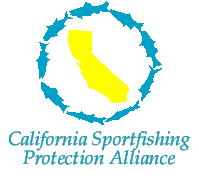September 2, 2008 Dear Caples Lake fish rescue volunteers, We want to take the opportunity to thank all of you for responding to our call to help the Department of Fish and Game capture and relocate over 6,000 fish from Caples Lake to Red and Silver Lakes. The volunteer effort had many successes, and some shortcomings. In addition to thanking you, we want to talk briefly about some of those, congratulate you for the things that went well, and apologize for things we might have done better. Above all, we rescued a lot of fish. DFG has been reluctant to attempt fish rescues in the past. But after the loss of thousands of fish at Prospect Island in the Delta last year, and this year’s success of AB 1806, which directs DFG to develop plans to rescue fish when the need arises, DFG’s approach has changed. Already, this June, Joe Johnson, DFG deputy commander at the Caples operation, led a very successful rescue of 350 Spring-run salmon in Butte Creek. As a close second, we showed at Caples Lake that a coordinated volunteer effort could be done, done quickly, and integrated into a large DFG operation. DFG has never before attempted to work with volunteers at this level. While not seamless, it was workable. We provided a lot of value-added to the operation. DFG thought going in that inexperienced people would not do well on the electrofishing boats. But people learned quickly, and it seemed that many of you were quicker with the nets on the E-boats than many of the DFG netters. The net brigades for moving fish were effective and executed perfectly. Finally, the volunteers added a positive spirit that improved the atmosphere for everyone. One problem in the process was that too many people had to wait too long with too little or nothing to do. For that, we are truly sorry. A lot of it had to do with the fact that DFG didn’t know going in what capture techniques would work. When it became clear that the nets weren’t working, and that night electrofishing was out-producing daytime electrofishing about 100 to 1, we tried to adjust the schedules to the required tasks. Thanks so much to everyone who showed up in early afternoon and agreed to come back in the evening. In retrospect, we probably signed up too many volunteers. We wanted to be fair in whom we selected, and the most straightforward way to be fair was to say yes to everyone who applied on time. We hope that the opportunity to talk to so many interesting and enthusiastic people made up in part for some of the waiting. For us, talking with many of you was a high point of the experience. The use of the web to sign folks up was essential, and went very well for the most part, problems with ancient software excepted. Jerry Neuburger, CSPA’s Webmaster, deserves a big thanks for organizing that end of the project. Jerry also did a daily web chronicle, with photos, of the rescue, which is still posted on the Home page of the CSPA website. If you are interested in more information about the work done by our organizations, or if you are interested in joining in our respective efforts to protect fisheries, please visit our respective websites at http://www.calsport.org and http://www.sac-sierratu.org. Thanks again for your good will, your dedication to fish, and your hard work in making the Caples Lake fish rescue a big success. Yours,
| |
| Chris Shutes FERC Projects Director CSPA | Barbara Bania President, Sac-Sierra Chapter Trout Unlimited |

